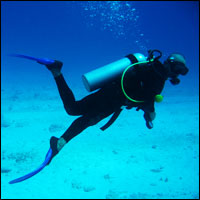
The right diving gear makes all the difference. Here’s what’s trending in underwater technologies.
Scuba divers always have relied on gear that lets the essentially fragile, air-dependent human body descend into oceanic depths. While air tanks, regulators, buoyancy control devices and dive computers have been around for years, digital technologies are altering how they function, how they’re used, and how well they work.
Taking the Plunge
One recent innovation is iGills, a system that with an app and a waterproof case turns an iPhone into a dive computer.

“The inspiration for iGills came from a love of diving and looking for opportunities to enhance the diving experience,” Matt Weakly, president of iGills developer Amphibian Labs, told TechNewsWorld. “We use smartphones for everything else, and their computing power far exceeds that of any dedicated dive computer. It was a natural fit to leverage smartphones for this application.”
The system — which soon will expand into the Android market — makes use of the phone as a computer to provide vital information to the diver. It also taps into the phone’s other functions.
“While you dive, the system continuously gathers data about the environment and provides full dive computer functionality through the smartphone screen,” explained Weakly. “Additionally, the system allows divers to take photos and video, creates a feature-rich dive log, and provides auxiliary features such as a digital compass and flashlight.”
Convincing divers to rely on a phone in place of a traditional dive computer is one hurdle faced by iGills, but it is not an insurmountable one, according to Weakly.
“There is always going to be some hesitation to putting your phone in a housing and taking it underwater, but as more and more are diving with iGills, it is just becoming the new normal,” he said. “The system is very easy to use and reliable. We are able to control and limit what the phone platform is trying to do while diving. It’s not running other apps or searching wireless signals. It is essentially in a state where the iGills app is front and center and has all the resources it needs.”
Ultrasound Monitoring
Another innovation, incorporated into Liquivision’s Lynx dive computer, is the use of ultrasound waves instead of radio waves for air and location monitoring. The use of ultrasound technology gives the system a range of around 330 feet, making it particularly useful for diving groups, families or classes.
“It does wireless air monitoring and location monitoring,” Rory Johnston, marketing supervisor with Liquivision, told TechNewsWorld. “It allows you to monitor your own air pressure and that of up to nine other people. You can always have your air — or that of your class or your family — on your screen. It’s a great safety feature.”

Ultrasound waves travel more efficiently than radio waves in the water, giving the Lynx greater range and flexibility than a traditional dive computer.
“Radio waves work well in the air, but underwater they have a limited range, about four or five feet,” said Johnston. “It works for your own air, but as soon as you try monitoring other people, the range isn’t there.”
The only drawback, according to Johnston, is that divers might become enthralled by the brightly lit, color-coded OLED screens on their wrists.
“It’s hard not to stare at the computer too much,” said Johnston. “It’s a bit like playing a video game. It’s almost too interesting.”
The Technology of Simplicity
Simplicity is particularly important for divers, who must attend to many different readings, sensations and adjustments simultaneously. Some new dive technologies, like Aqua Lung’s Legend LUX and LX regulators, focus on making diving gear easier to use.
“Other regulators may have a control knob and a venturi switch that the diver must contend with while diving,” Tom Phillip, Aqua Lung’s dive division product manager, told TechNewsWorld. “It can be too much for some divers to deal with. The innovative Master Breathing System allows one simple knob to control multiple regulator functions. It makes diving easier and gives divers one less thing to have to think about while diving.”
For buoyancy control, Aqua Lung’s i3 Control System also focuses on simplicity, using a finger lever for inflation and deflation of the buoyancy compensator.
“Using push-rod technology, as found in small aircraft, a diver is able to open multiple dump valves on his BC at one time by depressing a simple lever,” said Phillip. “This makes diving safer by allowing for rapid location and activation of the inflator to establish buoyancy at the surface in the case of emergency. Furthermore, it eliminates potential out-of-control-ascents caused by the diver activating the incorrect dump valve.”
Lighter, simpler equipment also travels well — something that Aqua Lung is taking into account as it develops new gear.
“Aqua Lung’s scuba gear will continue to evolve by getting smaller, lighter-weight, more comfortable, and easier to use,” said Phillip. “Divers love to travel to tropical destinations. Airlines continue to impose baggage fees. Smaller, lighter-weight equipment is what today’s traveling divers are demanding, and we will continue to meet their needs.”




















































